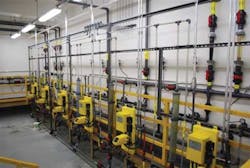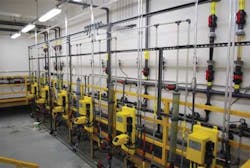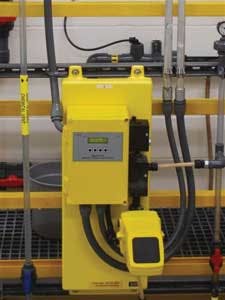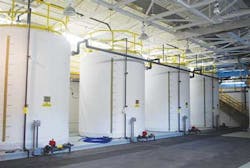By Cliff Lebowitz
Operations management for a municipal water filtration plant reports a successful change in chlorination systems that will continue to provide for effective disinfection while better meeting safety and efficiency criteria.
The plant has a treatment capacity of about 150 mgd. Average flow is about 50 mgd. For chlorination, the plant previously relied on three chlorinators capable of feeding 2000 lb. of chlorine each, 24/7, with typically 12 chlorine cylinder tanks delivered every two weeks, and 18 cylinders on site at a time.
In 2006, the facility switched to a vacuum-driven sodium hypochlorite (NaOCl) delivery system that includes four 11,000 gallon tanks for storage. The bulk-purchased NaOCl is delivered by a 4500-gallon tanker truck, and six patented, metered feeders provide a total of 1300 gallons per day for their treatment train via nine different application points.
"We had always wanted to do something that was safer, even though we never had any incidents, and especially after OSHA and EPA emergency preparation requirements got more rigorous," said the senior plant operator. "We heard of municipal treatment plants going to sodium hypochlorite. We wanted to find out what the newest equipment was and how to feed it safely and efficiently, without failures, from storage to delivery point.
"We've experienced very reliable performance with this new system for over five years, with no incidents of having to shut it down, or take the complete system off line. The feeders are fairly easy to control for the dosages we need."
System Selection
The operator said the city first considered staying with chlorine gas, which was not easier to feed but was certainly cheaper by the pound, with 12.5% sodium hypochlorite typically giving them only 1.1 lbs. of chlorine per gallon.
"But we saw that using hypo would make it much easier to control any leaks and would also require less employee training for the federal RMP emergency response plans," he said. "Another driving factor was that there appeared to be less maintenance with a liquid chemical feed system, as opposed to a chlorine gas system.
"We looked at making a 0.8% solution, which was impractical because we couldn't produce enough in a day to meet our demand, or making a 12.5% solution, which was much more involved than what we wanted to get into, requiring 50% of an operator's time each day. So we decided to buy bulk."
The selection process then moved to whether the NaOCl delivery system would be pump-driven or vacuum-driven.
"We were very concerned about reliability if we lost electricity, even though we have backup generators," he noted. "We do lose electricity. All we needed with a vacuum-driven system was our large water tank on a hill to provide the water pressure we needed to operate the feeders. We wouldn't need electricity to power the metering pumps.
"We also knew there could be big problems with off-gassing in a hypo system. We wanted the system to keep working even if there was air building up in the delivery lines from the storage tanks to the feeders. So we settled on a vacuum-driven system, and started calling vendors, asking for references, and getting units on a trial basis for one to two weeks."
The operator reports that among four or five vendors that were consulted, one stood out.
"Some hypo systems became air-bound, while others had the feed rate drop off, or lacked electronic flow meters that we needed for the plant's SCADA control," he said.
Selected System
The utility selected feeders offered by JCS Industries.
"The JCS system we decided on uses water as a carrying medium for the hypo, so it doesn't have off-gas problems, and we can confidently base a feeder a long way from an application point. We have one feed line that's a mile and a half long, and five others that are over 1000 ft. each."
"This system keeps working even if there's air going through it," he continued. "It also provides the electronic flow meters we needed so, for example, if we want to feed 5 gal./hr at a particular application point, we enter the dose or amount needed into the SCADA system, and since there is a flow meter on the feeder, it will go to that rate and stay there. Our SCADA system also receives a flow signal from several flow meters to keep the dose in the proper range.
"You can enter the dose or amount you want, and if the flow drops off because of an air bubble or the storage tank getting low, the feeder automatically adjusts the valve to maintain the desired flow. There are several alarms that advise the plant operator if the feeder cannot reach the desired flow that was called for in the SCADA system.
"We like this type of feedback loop. We also like the system being under a vacuum because we don't have to worry about a metering pump failing due to air binding."
Each of the six feeder units has a capacity of 10,000 gal./day, but is sized to 2000 gal./day, with a Venturri eductor creating the vacuum. Application points are prior to coagulation; at the flocculation basin effluent; and at the combined filter effluent. There is also capability for applying the hypo at two clearwell exits, as well as to untreated water that goes to a pulp mill.
Product Information
The JCS Industries hypo feeders used at the plant can feed a variety of aqueous chemicals commonly used in municipal and industrial water treatment systems.
The system comprises a vacuum injector to safely introduce the liquid into the feed-water stream; a reversing servo motor coupled with a V-notch valve to regulate the chemical feed rate; an electronic flow sensor to monitor and regulate the feed rate; and a control module for complete electronic control and communications.
The feeder will automatically regulate in both fixed and variable control modes, including fixed feed rate, flow paced, residual control, and compound loop.
A plant's water flow rate and/or a chemical residual signal are used to adjust the disinfection chemical liquid flow rate by electronically positioning the servomotor driving the feed control valve. The ratio of input signal to liquid flow is adjustable over a range of 5% to 400% to enable increased liquid feed in response to additional chemical demand.
About the Author: Cliff Lebowitz is an independent reporter and editor. His third-party case histories, usually industrial equipment applications, are based on interviews with end users and their engineering firms, and are approved by them for accuracy and completeness.






